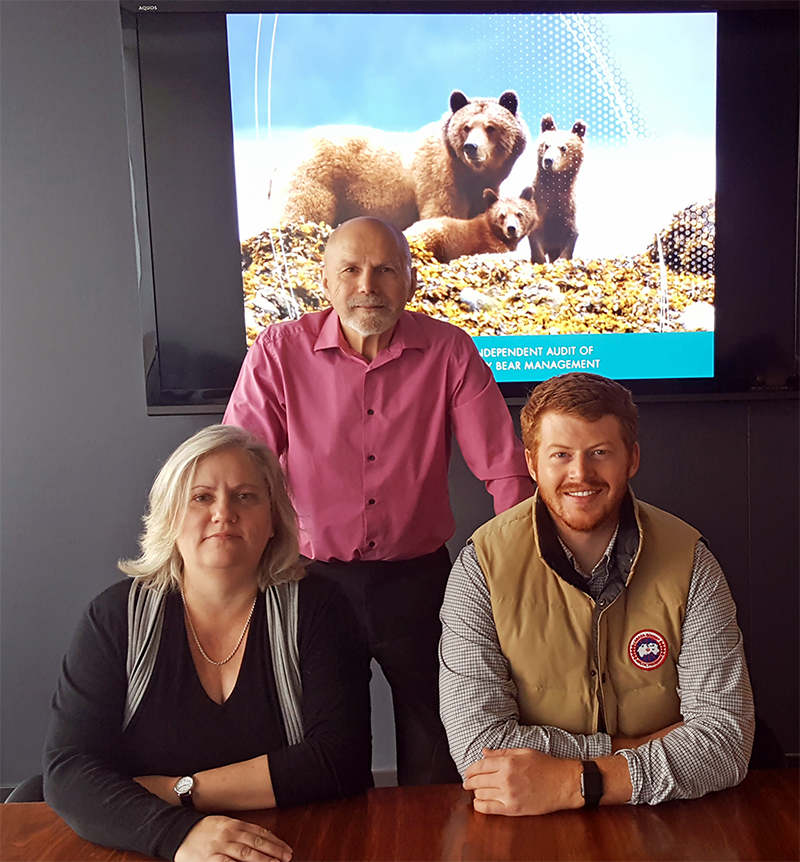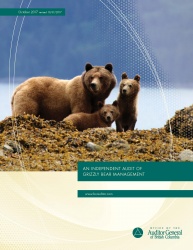
What is this audit about?
British Columbia is one of the last areas in North America where grizzly bears live in their natural habitat. The health of the province’s 15,000 grizzly bears is an indicator of how well the ecosystems and the species that live there are doing. In other words, if grizzly bears are not faring well, it’s a sign that the ecosystems as a whole are facing challenges.
In British Columbia, under the Wildlife Act, the government has ownership of all wildlife in the province. Prior to 2011, the Ministry of Environment (MoE) carried out grizzly bear management. However, this changed when the Fish and Wildlife Branch was moved from MoE to the newly created Ministry of Forests, Lands and Natural Resource Operations (MFLNRO).1
The audit examined the British Columbia government’s management framework for grizzly bears to determine if it was meeting its objective of ensuring healthy grizzly bear populations throughout British Columbia.
What did the audit find?
The audit report explores many facets of grizzly bear management in British Columbia. The audit findings are framed within a cycle of continuous improvement: the Plan-Do-Check-Adjust cycle.
Using this approach, the audit’s findings addressed a range of topics.
Planning
The audit found that there was no plan to implement the strategic direction for grizzly bears in the province. The key document that guides grizzly bear management in British Columbia is the Grizzly Bear Conservation Strategy. Created in 1995, it has not been revised in over 20 years. Both ministries (MoE and MFLNRO) refer to the plan as a guiding document but neither ministry has taken responsibility for updating it.
Recovering Populations of Concern
There have been limited actions taken for threatened grizzly bear populations. Out of the 56 grizzly bear populations, 9 are threatened. The government’s primary objective for these threatened populations is to recover them to a sustainable level. However, government has created only one plan for one population, and it has never been implemented.
Managing Human-Related Threats
The conservation officer service within the Ministry of Environment responds to calls related to human–bear conflicts and works to reduce illegal activities such as poaching or failing to report a bear killed due to conflict. The number of incidents attended by the conservation officers is on the rise, and the conservation officer service has not evaluated whether it has sufficient resources or tools to meet this growing demand.
Also increasing is the number of grizzly bear viewing operations. Bear viewing provides economic opportunities in the province but can have negative impacts on grizzly bears. This activity is currently not regulated. Finally, over the years, the MFLNRO has made advances in its hunting policy and procedures.
However, reviews of grizzly bear hunting by external experts, both in 2003 and in 2016, indicated that government can still make improvements such as better grizzly bear population monitoring, increased public consultations, and additional funding for grizzly bear harvest management.
Providing Secure Habitat
The audit found the greatest risk to grizzly bear populations in British Columbia is not from hunting. Rather, it is the degradation of grizzly bear habitats from human activities. For instance, the increasing length of resource roads (over 600 000 km) in the province has allowed greater human access to grizzly bear habitats that can result in unregulated hunting activity and a growing number of human and grizzly bear conflicts.
Providing secure and connected habitat for grizzly bears is critical for conservation of this population. However, there is no connectivity strategy for provincial parks and there is an overall lack of initiatives to address the need for wildlife corridors and safe transition areas.
The ministries have undertaken activities to reduce grizzly bear habitat degradation and provide secure habitats, but for most of these activities, they have not evaluated whether these efforts are effective. Without a process for reviewing and adjusting their activities, it is difficult for the ministries to ensure that grizzly bear populations throughout the province are being maintained.
Reporting
The audit found that the government is publicly reporting on grizzly bear populations and mortalities on its website, in peer-reviewed scientific journals, and through some First Nations consultations. The website, though, is incomplete as to the activities that have been undertaken and does not include activities related to performance measures.
What difference did the audit make?
The report generated a lot of interest. Grizzly bears are an iconic and challenging species to manage. Therefore, the audit generated great interest from the media, stakeholders, and the public. It was the most popular report on the OAG’s website during the year after release, with 1,890 downloads.
The audit found that the main reason why the ministries had not met many of the expectations was an unclear organizational structure and unclear accountabilities. It recommended that government review its legislation and policies and clarify the responsibilities between the two ministries involved.
The audit made nine other recommendations, including:
- creating a management plan for grizzly bears that is based on adequate inventory and monitoring of the bear population,
- improving hunting policies,
- regulating bear viewing,
- ensuring that the conservation officer service has adequate tools and resources, and
- evaluating and adjusting activities that mitigate threats and protect grizzly bear habitat to ensure that they are effective.
The ministries agreed with the audit findings, accepted the recommendations, and indicated their intention to implement them. They produced a detailed action plan with target dates between March 2018 and March 2020. This action plan was presented at the Select Standing Committee of Public Accounts in March 2018 and the Committee will request an annual update.
In December 2017, the British Columbia government announced that it was bringing an end to grizzly bear hunting throughout the province, although First Nations are still able to harvest grizzly bears in accordance with Aboriginal rights for food, social or ceremonial purposes, or treaty rights. The audit did include aspects of grizzly bear hunting, but it did not question the merits of the policy. There is no acknowledged link between the audit and this decision, which was announced after the audit was tabled. However, the audit will certainly have a substantial impact on grizzly bear management through the implementation of some recommendations.
What can we learn from this audit?
A common challenge faced by this audit was the complexity of the subject matter, and how it could be tackled. Grizzly bear management is a good example of a government program dealing with a number of intersecting issues. Scientific, environmental, economic, logistical, cultural, and even ethical considerations pervade government interventions in this sector. Therefore, the audit team had to come up with a number of strategies to address this complexity and capture the essence of this program.
A recognized generic management framework is a useful way to structure an audit
The audit team decided to base the audit approach on the continuous improvement framework, which is derived from the Quality Management and ISO 9001 literature. The framework is grounded on an iterative four-step management method known as Plan-Do-Check-Adjust, used in business for the control and continual improvement of processes and products. This approach is recognized internationally as a good standard for program management. In addition, expectations that government would report publicly on its performance were included in the framework. It was used to articulate the lines of enquiry and criteria.
When planning an audit of a complex scientific topic, you may have to take stock of emerging information
In March 2016, the Ministry of Forests, Lands, and Natural Resource Operations released an Independent Scientific Review on Grizzly Bear Harvest Management. This made the audit team reconsider the value of an audit of grizzly bear management. The team decided to carefully analyze the review and conduct additional interviews and internal consultations to ensure the audit would still add value. It was found that the scientific review had a narrow scope, mainly focused around hunting and that a broader audit of overall grizzly bear management would provide more information.
Access to the right expertise is essential
Given the complexity of the subject matter, the audit team needed access to relevant expertise, in order to validate its interpretation of the evidence and its conclusions. The audit team complemented its knowledge and experience auditing this type of program by working with two specialists: a retired bear management expert and a field scientist. Both represented the academic and applied sides of the science. They provided a sounding board for the team and strengthened the report’s credibility.
Moreover, the audit team interacted with a number of world-class scientists working for the ministries on the management of grizzly bears and needed to ensure that they asked the right questions and interpreted the answers correctly.
Engaging stakeholders provides important perspectives
The audit touched on a number of cross-cutting issues, involving diverse organizations and communities. The audit team spoke to numerous stakeholders, including non-government organizations, guide outfitters, academics, bear viewing operators, and First Nations. These conversations highlighted the key issues and the material and human impacts of shortcomings identified by the audit team. Field visits of grizzly habitats presented great opportunities to appreciate the physical reality and challenges of managing fauna, while enabling meetings with stakeholders, where it mattered to them.
Clearing a complex technical audit report requires a substantial investment of time and effort
When conducting a performance audit, obtaining feedback from the organizations audited is essential to ensure the report’s accuracy and appropriate tone. In the case of this audit, feedback from the ministries proved crucial and very beneficial. Clearing the report with 11 different individuals (primarily scientists) resulted in a significant dialogue, including an epic clearance meeting that involved three Assistant Deputy Ministers and lasted seven hours. This dialogue provided opportunities to adjust the report’s language and ensure that messages were adequately formulated. It also provided opportunities for the ministry representatives to add value, and reflect on issues around scientific uncertainty, risk levels, and adequacy of various alternative management strategies. The audit team felt that taking the time to review each comment and sharing their disposition with the ministries resulted in better buy-in at the end of the audit.
A longer report is sometimes justified
The final audit report is 72 pages long. The Office of the Auditor General of British Columbia sometimes produces longer reports because it strives not only to provide its audit findings but also to educate the public and elected officials about selected topics. Hence the report’s background section takes six pages and there are five case studies in appendices that cover 10 pages. Moreover, the report includes many maps and diagrams which aid in improving readability. Therefore, while the report is 72 pages, the audit itself is only 44 pages – with about half of those pages being graphics. The remaining pages include appendices, an executive summary and the government response. Moreover, besides the audit report itself and the executive summary, a reader can obtain information through a one-page infographic and a narrated slide presentation. The Office also ensured that the audit report was couched in plain language. The positive reception of the report by the ministries, stakeholders, the Select Standing Committee on Public Accounts, and the public demonstrated that, when the complexity and importance justify it, audiences can digest a longer report that does justice to its subject matter. By performing a public education role, the audit strengthened accountability.
1After the audit was completed, the Ministry of Environment became the Ministry of Environment and Climate Change Strategy and the Ministry of Forests, Lands and Natural Resource Operations became the Ministry of Forests, Lands, Natural Resource Operations and Rural Development. > back to top
Audit Team

Left to Right: Ardice Todosichuk, Director; Morris Sydor, Assistant Auditor General; Cameron Giannotti, Research Administrator

Access the Report

See more Featured Audits


